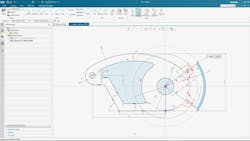It was just nine months ago, in September of 2019, that Siemens PLM announced a name change—to Siemens Digital Industries Software—and a new product brand called Xcelerator. The Xcelerator portfolio combines design, engineering, and manufacturing software and includes applications for product lifecycle management (PLM), electronic design automation (EDA), application lifecycle management (ALM), manufacturing operations management (MOM), and the MindSphere IoT platform.
This week, during the Siemens Media & Analyst Conference virtual event, executives announced enhancements to its portfolio that includes cloud-based PLM, artificial intelligence-enabled sketching technology for CAD, and a partnership with IBM that has resulted in a service lifecycle management (SLM) offering.
First, Teamcenter X software is a new software as a service (SaaS) PLM product that offers preconfigured engineering and business applications, as well as built-in best practices to deliver immediate value to companies of all sizes, the company said.
Teamcenter X is built using industrial components from Siemens’ Mendix cloud-native, low-code application development platform. And using a SaaS extension to Xcelerator, applications can be connected for collaboration across the enterprise and across functional domains.
Described as having “instant-on” access to the cloud—meaning, like a video game, it leads the new user through how to use the software—Teamcenter X supports a multi-domain digital twin, combining electrical, mechanical, and software elements into a single bill of materials (BOM). There is integration to NX software and Solid Edge software for mechanical CAD, Mentor software for electronic CAD, and Polarion X software for ALM. In addition, preconfigured functions, such as engineering change, release management, and more, help users work more efficiently.
“The value of the digital twin is how closely the virtual world represents the physical world,” said Tony Hemmelgarn, president and CEO of Siemens Digital Industries Software, noting the Siemens digital twin covers the entire product lifecycle and has a closed loop to feed information back into the models. “The closed loop approach is also actionable, from simple processes to the most complex. Many tool providers say they can solve complex issues, but customers say it requires more than tools. It needs an integrated solution.”
And an integrated software suite is what Siemens is building. Specifically, Hemmelgarn said the Siemens strategy focuses on three business imperatives: the digital twin, a personalized work approach, and a flexible, open ecosystem.
Share, Sketch, Service
From a personalized work perspective, another aspect of the offering is called Teamcenter Share, to be delivered later this summer, which is a cloud-based design-centric project collaboration tool that can synchronize files with cloud storage while the user works. It also allows the user to view, measure, and markup and CAD file on any device, securely shares projects with anyone, and reviews designs in augmented reality (AR) on phones and tablets.
Another new product within the Xcelerator portfolio is NX Sketch, a software tool that allows users to sketch without pre-defining parameters, design intent, and relationships. Using artificial intelligence (AI) to infer relationships on-the-fly, users can move away from a paper hand sketch and create concept designs within NX, making it easy to work with imported data while allowing rapid design iterations on legacy data.
“Sketching is at the heart of CAD and is critical to capturing the intent of the digital twin,” said Bob Haubrock, senior vice president, product engineering software at Siemens Digital Industries Software. “Even though this is an essential part of the process, sketching hasn’t changed much in the last 40 years. Using technology and innovations from multiple past acquisitions, Siemens is able to take a fresh look at this crucial design step and modernize it in a way that will help our customers achieve significant gains in productivity and innovation.”
Lastly, honoring Siemens commitment to an open ecosystem, the company has partnered with IBM to deliver service lifecycle management of assets by dynamically connecting real-world maintenance activities and asset performance back to design decisions and field modifications. This new end-to-end digital thread between original equipment manufacturers (OEMs) and the owner/operators of that equipment leverages aspects of Xcelerator as well as IBM’s enterprise asset management software called Maximo, which uses advanced analytics and IoT data to improve performance and reduce downtime.
According to the companies, OEMs and owner/operators can struggle to improve the performance and reliability of an asset over its operating lifecycle due to inefficient data sharing between engineering, operations, and maintenance processes. This joint product from Siemens and IBM creates a single source of information designed to help both parties improve many aspects about how they design, maintain, and service their assets. In addition, it enables OEMs to provide valuable after-market services to their clients as part of a product-as-a-service business model.
SLM enables OEMs to receive critical data about asset performance, maintenance, and failures in the field. Leveraging IoT technology, manufacturers can gain insights on wear and tear, operating conditions, parts failures, and other patterns that lead to design or manufacturing updates. This data can be used to help manufacturers lower maintenance costs, reduce risks, and improve asset resiliency.
According to Siemens, what’s been missing in SLM is the ability for analytics to address physical issues of the asset when planning. For example, the configuration, if the required information was captured correctly, if changes are critical to performance, or how dependent assets impact each other. This requires engineering and operations working together as one orchestrated solution.
“We’ve worked with IBM to improve aftermarket services by combining asset management and PLM capabilities, delivering a closed-loop service lifecycle management solution that spans design, service, planning, and maintenance,” said Hemmelgarn. “It’s great to work with IBM as a partner versus a competitor.”
For more coverage on Siemens Digital Industries Software:
Leaders relevant to this article:


